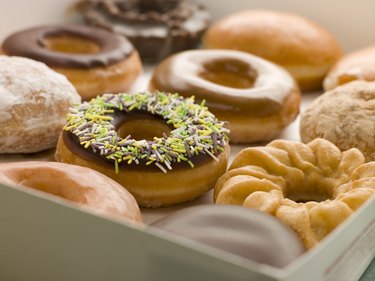
Most parts of your body, with the exception of your stomach, intestines and a few other tissues, are meant to be alkaline, which means not acidic. Your blood, for example, is strictly maintained as an alkaline fluid because oxygen, nutrient and waste exchange occurs most efficiently in a basic environment. Alkalinity also deters pathogenic microorganisms. Many foods and beverages in the standard American diet are acidic, meaning they lower your body's pH levels and may contribute to poor health. Consult with a nutritionist if you are concerned about balancing your pH levels.
The pH Scale
Video of the Day
The pH scale is a standardized method of measuring acidity based on the number of hydrogen ions formed when a substance is mixed with water, according to ScienceBuddies.org. An acidic solution contains lots of hydrogen ions and is assigned a number less than 7 on the negative logarithmic pH scale. Purified water is considered neutral and assigned the number 7, and anything with fewer hydrogen ions than water is assigned a number between 7.1 and 14. Stomach acid is typically between 2 and 4 on the pH scale and is capable of taking electrons away from molecular substances, which metabolizes them and reduces them into smaller "building blocks." High acidity in your stomach is necessary, although most healthy cells are above 7 on the pH scale. Eating acidic food forces your body into certain compromises.
Video of the Day
Effects of Acidic Foods
Highly acidic foods change your body chemistry over time and force your body to reduce or buffer the over-acidity in fluids and tissues. Keeping your blood alkaline, near 7.4 on the pH scale, is a top priority for your body and liberates alkaline-enhancing minerals from your bones to combat excessive acidity. Long-term consumption of highly acidic foods and beverages may contribute to bone diseases such as osteoporosis and osteoarthritis, according to the book "Human Biochemistry and Disease" by Gerald Litwack. Further, low pH levels stimulate the growth and proliferation of bacteria, viruses, fungi, parasites and even cancer cells. Acidity, because of its electron-stealing property, also tends to reduce voltage and energy levels in the body.
Foods That Lower pH
Acidic foods don't always lower pH levels. Citrus fruits, for example, contain citric, ascorbic and malic acids, but they have an overall alkalizing affect on the body. In general, fruits and vegetables, no matter how sour they taste, have an alkalizing affect, whereas highly processed, sugary foods always promote acidity. Common foods in the American diet that lower pH levels include donuts, cookies, candy, highly preserved sauces and condiments, anything baked with white flour, foods high in trans fats and anything containing high-fructose corn syrup or artificial sweeteners. High amounts of meats, cheeses and white rice are also acidifying.
Beverages That Lower pH
Beverages may contribute to lowering your pH levels more than food because virtually any beverage -- aside from purified water, green and herbal teas, freshly squeezed fruit and vegetable juices and raw milk -- has acidifying properties. Examples of acidic beverages include coffee, black tea, soda pop, energy and sport drinks, wine, beer, spirits, juice from concentrate and even commercially produced milk. Most municipal water is mildly acidic due to the chemicals added and the presence of drug residues that cannot be filtered, according to "Nutrition Concepts & Controversies." Water filtration systems can make water more acidic because they often remove the alkalizing minerals along with the chemicals. Convenient pH test paper can be used to gauge acidity of liquids.
Is this an emergency? If you are experiencing serious medical symptoms, please see the National Library of Medicine’s list of signs you need emergency medical attention or call 911.